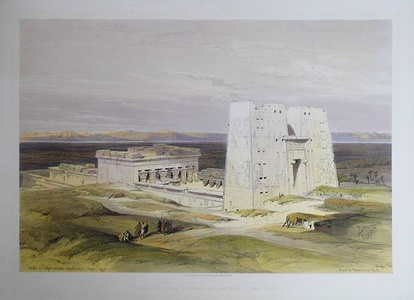| Method | Lithograph with tint stone and hand colouring |
| Artist | Louis Haghe after David Roberts |
| Published | London, Published by F. G. Moon, 20 Threadneedle St, March 1st, 1847 |
| Dimensions | Image 335 x 500 mm, Sheet 420 x 616 mm. |
| Notes |
A general view of the monumental gateway pylons, courtyard, and portico of the Temple of Horus at Edfu, on the west bank of the Nile. The temple complex was constructed during the Ptolemaic era to serve the important Greco-Roman cult city of Apollonopolis Magna. A combination of disuse and annual flooding by the Nile meant that by the 18th century, the temple was buried in 12 metres of sand and river silt, with only the tops of the ornate columns showing. The temple was excavated in the 1860s. Its columned facade and its flax-plant decoration inspired the architect of the Temple Works in Leeds, itself a flax mill. Robert's view depicts the temple complex in full, drawing attention to the massive scale of the entrance gateway and its reliefs of pharaonic figures smiting the enemies of Egypt. In the foreground, a small group of soldiers armed with long spears is gathered on a dune near the temple. David Roberts, Yesterday and Today; Egypt, 126, Plate 49. David Roberts RA (1796 – 1864) was a Scottish painter. He is especially known for a prolific series of detailed prints of Egypt and the Near East produced during the 1840s from sketches made during long tours of the region (1838-1840). This work, and his large oil paintings of similar subjects, made him a prominent Orientalist painter. He was elected as a Royal Academician in 1841. Condition: Good clean impression. Light stain from previous mount in margins, not affecting the image. |
| Framing | framed |
| Price | £1,000.00 |
| Stock ID | 33493 |

